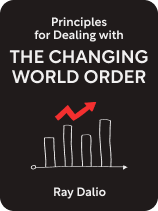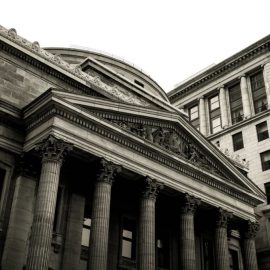

This article is an excerpt from the Shortform book guide to "Principles for Dealing with the Changing World Order" by Ray Dalio. Shortform has the world's best summaries and analyses of books you should be reading.
Like this article? Sign up for a free trial here.
Is the world moving in predictable patterns? Can we learn from history to anticipate future events?
Every 250 years or so, an empire falls and a new one rises. The big cycle, Ray Dalio says, helps us understand history and predict the future. Inside this big cycle are smaller cycles of economy, society, and geopolitics that help shape the world order.
Keep reading for Dalio’s perspective on the cyclical nature of wealth, power, and global dynamics.
The Big Cycle (Ray Dalio)
Human history evolves through small cycles that center on a big cycle—the rise and fall of a major power (“empire”) and the world orders it creates. The big cycle, Ray Dalio contends, transpires roughly every 250 years and follows roughly the same broad pattern each time. For instance, the ways in which the Spanish, Dutch, and British Empires fought for, established, and managed their wealth and power have much in common. From many such examples, Dalio says, he derived a general pattern that describes all such cycles in a more-or-less accurate way.
(Shortform note: Much like Dalio, William Strauss and Neil Howe argue in The Fourth Turning that human history progresses through cycles of what they call “turnings.” Each cycle has four turnings, and each turning lasts around 15-25 years, such that each cycle ranges from 60-100 years in length. Strauss and Howe say that the same general themes and types of events will recur, more or less without fail, though they focus more on societal and political cycles than on economic and imperial cycles, which Dalio gives more weight in his model.)
Cycles, in Dalio’s model, are the cause-and-effect sequences of events that describe how empires rise, peak, and fall. Cycles drive the natural oscillation of the world between peace and war, prosperity and poverty, and the concentration of wealth and power here, there, or elsewhere.
Evolution, on the other hand, is the gradual accumulation of changes that build up as cycles unfold. Dalio says that during each cycle, humanity makes net gains that persist past the end of the cycle, such that we stand today on the shoulders of gains made through thousands of years of historical cycles.
Together, Dalio says that cycles and evolution lend a net positive trajectory to the unfolding of human history. Driving this upward movement is human inventiveness: According to Dalio, humanity’s innate drive to progress—to invent tools and technologies, to shape our environments, and to seek ever greater mastery of the world—makes the world steadily better over time.
(Shortform note: Here, Dalio’s view of cycles and evolution seems much like what others have called a “spiral” theory of time. In this theory, a linear view of history combines with the cyclical model (such as in The Fourth Turning) to give the view that history evolves or “rhymes” through thematically similar cycles, yet also has a trajectory to it. While Dalio argues that that trajectory is ultimately positive, Yancey Strickler contends in the above article that we risk a downward spiral if we repeat mistakes too frequently. The way to avoid this is to learn from our errors, as Matthew Syed argues in Black Box Thinking: Mistakes are essential to learning, so long as you properly absorb their lessons.)
Understanding this pattern matters, according to Dalio, because it allows us to see where we are, here and now, in the broader sweep of history. And, if we know where we are in the current big cycle, we can anticipate what comes next in order to better navigate life, business, investment, and so on.
(Shortform note: Strauss and Howe also preceded Dalio in pointing out in The Fourth Turning, which was published in 1997, that studying historical cycles can help us anticipate and adapt to the future. Specifically, they recommend that individuals thoroughly study the typical cycles and then adapt their behaviors and financial plans accordingly. For instance, if Strauss and Howe’s models suggest that your country is in the second turning (“awakening”), it’s a good time to embrace individualism and idealism and defy conventional social norms.)
The Competition for Wealth & Power
According to Dalio, humans have competed for wealth and power throughout history. He explains that, in studying the major world empires across the past few thousand years (though he focused on the most recent 500 years), he learned that people naturally fight over resources such as favorable land and food supplies. These basic resources can give one group an advantage over others, such as the ancient Egyptians who dominated the fertile Nile river valley.
With a resource advantage, a group can concentrate wealth, build a military advantage, and extend their dominance over larger areas. This pattern of competition, accumulation, and extension of dominion is the pattern on which Dalio’s model centers. It happens because, Dalio argues, basic emotions like fear, greed, and jealousy drive people to fight over the resources upon which survival depends.
(Shortform note: Similar to Dalio’s perspective but with an explicitly political intent, Karl Marx argued in The Communist Manifesto that human history is best understood as a class struggle over economic control. In his view, those who hold wealth and power control the economy (which early on, was largely the food supply), and those without wealth and power had to work to sustain their lives. Marx calls the concentration of wealth and power “original expropriation,” arguing that this class division comes from a history of violence where conquest and force put a small group of elites in power. Dalio’s model doesn’t contradict this—rather, Dalio’s concerns lie not in politics but in financial management, perhaps because he himself is of the wealthy elite.)
While Dalio derived his model from years of study of over a dozen major historical empires, it isn’t meant to be exact and can’t predict the future. Regardless, he believes it to be an accurate model of the logical sequences of causes and effects that govern how empires rise, peak, and fall.
(Shortform note: One way to understand Dalio’s perspective is as a large, complex mental model—a tool for thinking more clearly about the world. Mental models can be small enough to sum up in a sentence, like “the map isn’t the territory,” or large enough to warrant books, like Dalio’s Principles series. What he shares in common with Shane Parrish and Rhiannon Beaubien, the authors of The Great Mental Models series, is the recognition that we need these reliable mental tools, or frameworks for thinking, to make good decisions in our complex, fast-moving world. And however good your models, remember that “all models are wrong”—a sentiment Dalio acknowledges in admitting the inexactitude of his thinking.)

———End of Preview———
Like what you just read? Read the rest of the world's best book summary and analysis of Ray Dalio's "Principles for Dealing with the Changing World Order" at Shortform.
Here's what you'll find in our full Principles for Dealing with the Changing World Order summary:
- How to use patterns in world history to make better decisions today
- What may happen in the near future for the United States and China
- Why humans are stuck in a competition for wealth and power






